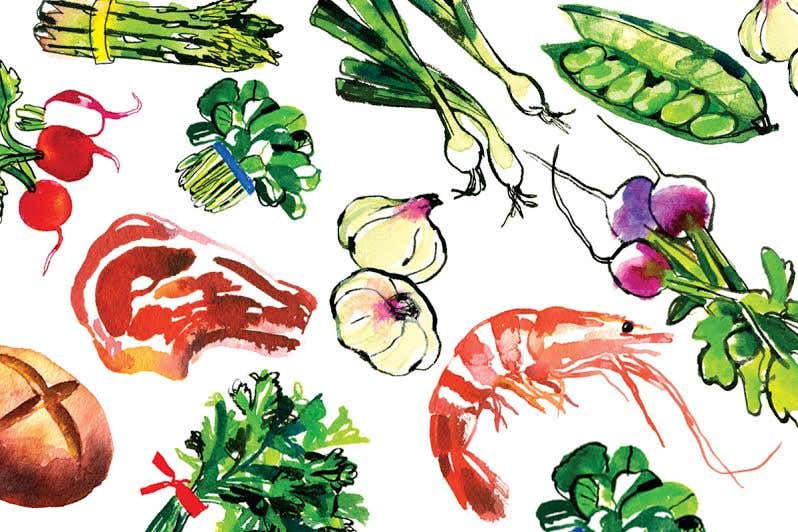
Château Steadman
Wine writers constantly seek fresh ideas for books. Ralph Steadman has gone them so many better in The Grapes of Ralph: Wine According to Ralph Steadman, that they might as well forget it. Others might look for new approaches; Steadman creates new worlds. And the matter of wine in Steadman's world is little fettered by reality, yet it intersects reality in so many details that it has a surrealist reality of its own. It's like the fourth dimension traversing the third. Neither you nor I know, of course, what that means—but it's the kind of thinking Steadman inspires.
This mad balderdash came about because the large British wineshop chain called Oddbins asked Steadman (who makes wine of his own at his home in Kent) to illustrate a catalogue for them. Oddbins seems a very English name (in this country, it probably would come out Superbins or Wonderbins), but for a chain of that name, Steadman was a natural. He did the catalogue and then wouldn't stop, doing countless more. Under Oddbins' beneficent tutelage, he and his wife ended up visiting most of the world's winelands; the result is this 200-plus-page folio of fripperies—an account of their travels, more or less.
Steadman is foremost an illustrator. Most Americans (he is British) probably first saw his work in Rolling Stone—where, among other things, he provided drawings for many Hunter S. Thompson pieces. His graphic style is volcanic; he is a Krakatoa of an artist. Everything moves, tumbles, churns. He seems to work in a place of unpredictably exploding paint pots.
There is text in this book—quite a bit—but it supports the art, sliding effortlessly from sober (or thereabouts) fact to unbridled fantasy. It is not surprising to learn that Steadman has illustrated Alice in Wonderland, Through the Looking Glass, and The Hunting of the Snark: His drawing is jabberwockian, and his prose is on the same lines. In a recent column in the New York Times, Frank Prial regretted the almost total lack of humor in American wine writing. In England, wine writers are less grim—though no one else's humor is so broad and sustained as this. Steadman must have a forked tongue, because he manages to keep it firmly planted in both cheeks most of the time.
Steadman's winefolk look variously mad, manic, maudlin, fey, bemused, brooding, angry, daft, gruff, sinister, sardonic, ribald, risible, lugubrious—anything but free and easy. His winemen—connoisseurs, critics, vintners, and the like—are as beaky as toucans. His ''wine critic'' is a study in smug imbecility. Beards and moustaches abound, most of them seemingly composed of scraggy clumps of pampas grass. There's lots of hair, all wild. The legendary Angelo Gaja looks like Lorenzo de Medici, with a nose that combines those of Pinocchio and Bob Hope. Other distinguished Italian winemakers look like mafiosi or evil cardinals. He creates a whole new mythology of German wines, with multiheaded dragons, many-eyed monsters, bloody miracles—and Helga, the fair wine maiden, who skips delicately in flowing raiment, a boozy floozy of 200 kilos. Though he does include a few serene, impressionistic landscapes, Steadman mostly seems to believe that nothing succeeds like excess.
Elsewhere in the book, a flock of turkey buzzards flies over a Napa Valley winery shouting wisecracks like ''Read my lips, Chard and Cab rule—O.K.!'' In Spain, the Sandeman Don balances titubantly on the company sign, a glass of sherry on his head. The English can still joke about being tipsy.
In his prose sections, rather than describing wines, Steadman offers his reactions to them: ''It made me think of rusty arrowheads launched at point-blank range into my solar plexus''; ''I gulped a mouthful which burst inside me like a warm sensuous bomb...the sheer joy of booze at the right moment''; '''Aaaaaargghhh!!!' I gargle, as I stand bolt upright...eyes bulging and now clutching my stomach''; ''I chose Algerian wine...very soft and very round, like sheep's eyes with square pupils. A woolliness too''. When Steadman reaches California, he finds himself ''amazed by the quanlity of Californian wines''. Yes, he does write ''quanlity''. (He seems to think, incidentally, that California is all high tech and vast scale—missing the profusion of tiny wineries run by fanatical quality hounds.)_
_
T__he Grapes of Ralph is a strangely engaging book. But don't believe everything (anything?) you read here. Steadman ascribes the conquering of phylloxera, for instance, to ''the now famous 'Bonfire of the Vineries,' when all the vineyards of Western Europe went up in smoke'' to purge them of the dreaded vine pest. Sure, Ralph.
Keep Reading
Continue to Next Story










